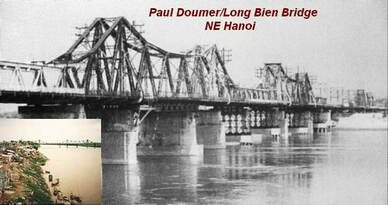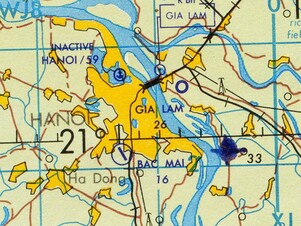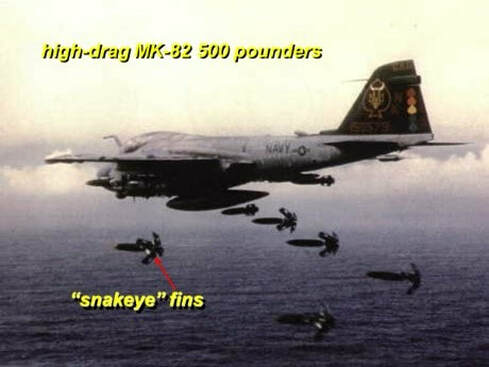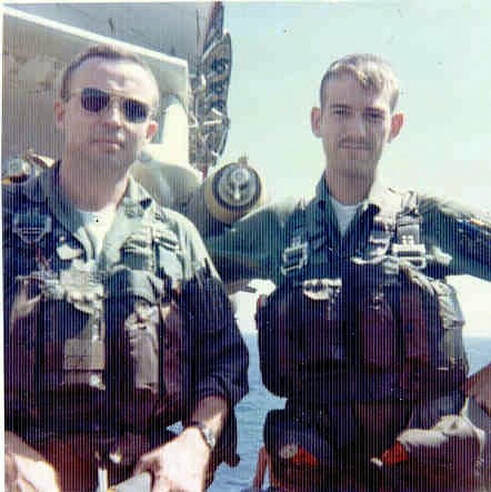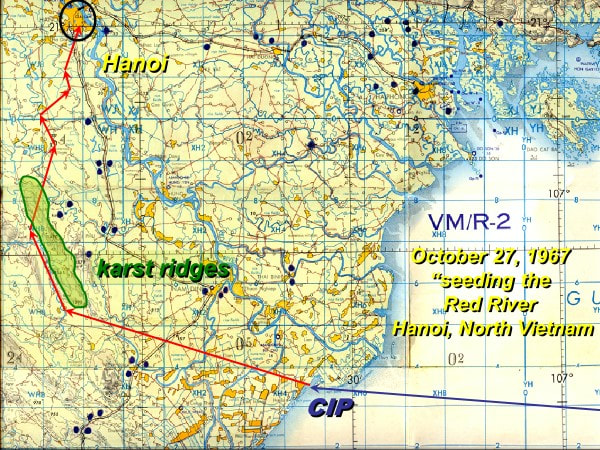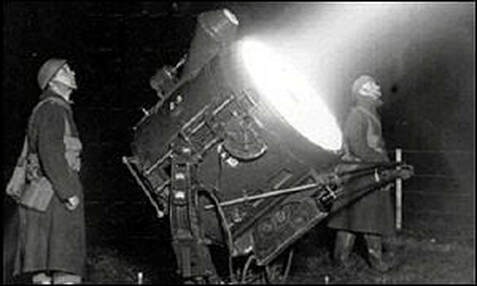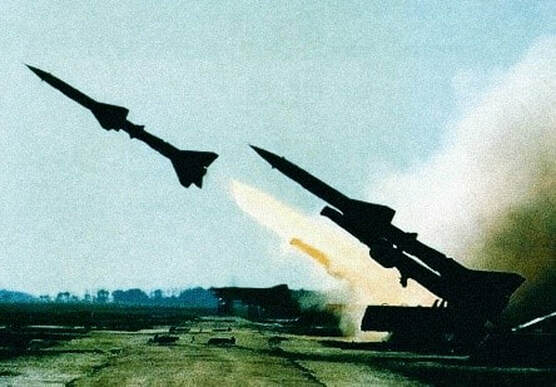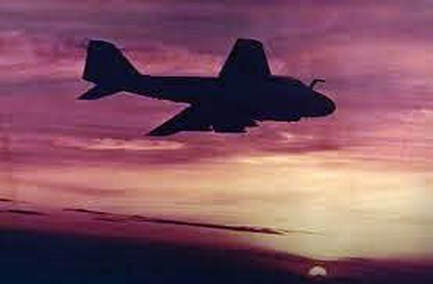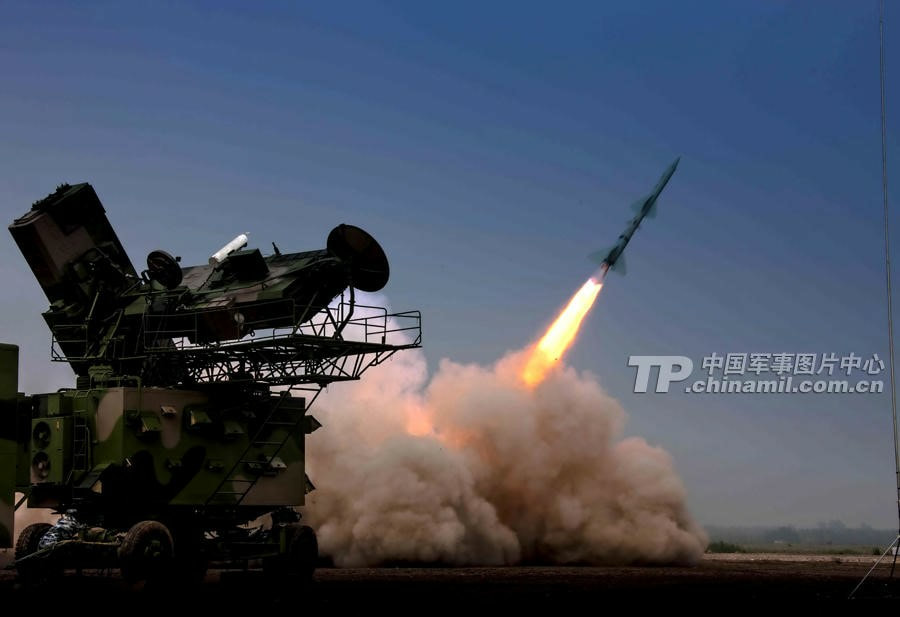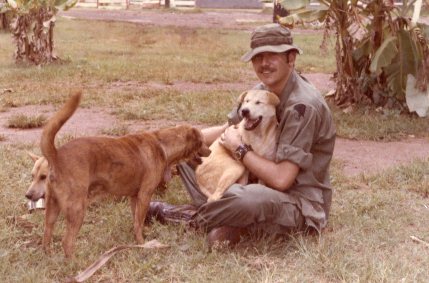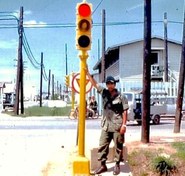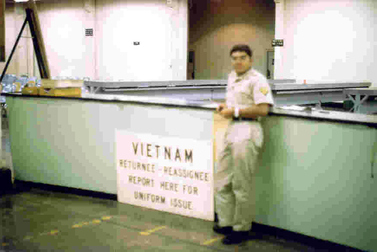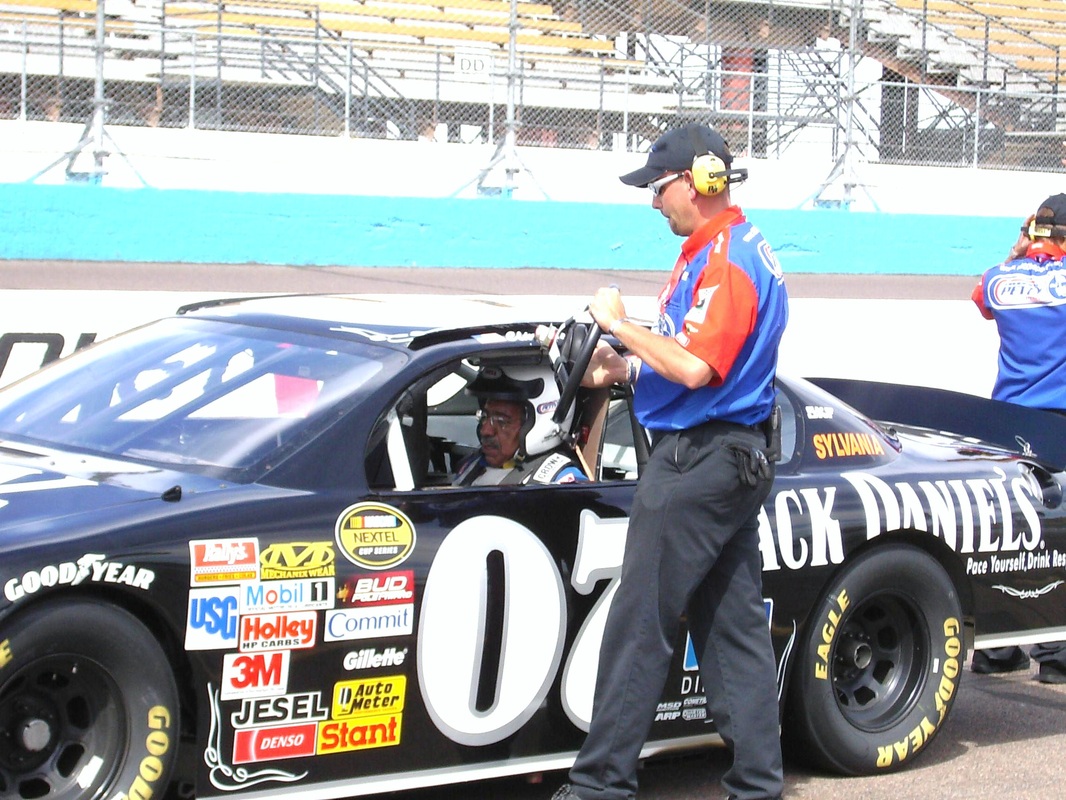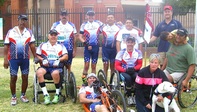Member's Stories
This page will be used to encourage our Chapter members to write a story and share it with the rest of the membership.
Your story can be about an experience you had while you were in the military or any life experience that you would like to share.
Make your story as short or as long as you want......make it factual or fictional......tell a sad or humorous story......it's up to you!
Email your story to webmaster.vva1071.org or give a printed copy of your story to Ray Holtz and he will post it on this page.
_______________________________________________________________________
PHIL WATERS - Goin' Downtown
Goin’ Downtown
In the Fall of 1967 when numerous air attacks had disabled the Paul Doumer (today Long Bien) bridge connecting Hanoi with the only rail line to Haiphong and China, the North Vietnamese began using a railroad spur that bypassed the bridge to a ferry crossing a few miles southeast of the bridge to move trains across the Red River. Intelligence advised us that they were ferrying trains at night hiding the ferry in the day time.
In the Fall of 1967 when numerous air attacks had disabled the Paul Doumer (today Long Bien) bridge connecting Hanoi with the only rail line to Haiphong and China, the North Vietnamese began using a railroad spur that bypassed the bridge to a ferry crossing a few miles southeast of the bridge to move trains across the Red River. Intelligence advised us that they were ferrying trains at night hiding the ferry in the day time.
In October of 1967, VA-196 was given the task of stopping this flow of munitions from Haiphong and China to the Ho Chi Minh Trail. 500-pound bombs with a Mark 36 fuse had become effective in stopping road, rail and river traffic inasmuch as the “destructors” were air-dropped on land or water and lay dormant until set off by any object, even a shovel, containing steel or iron. We began a series of night-time raids on this Kim Quan ferry crossing dropping strings of these Mk 36 “seeds” into the Red River in the vicinity of the rail spur.
It was common knowledge that in 1967, the Hanoi area contained the greatest density of anti-aircraft artillery (AAA) and surface to air missiles (SAMs) of any known location in the world since WWII. “Going downtown” was the expression describing a single A-6 night attack and was the most challenging of all the A-6 missions during the Vietnam War (poorly portrayed in
“The Flight of the Intruder” book/movie). The bottom line is to go as low as you dared and as fast as the Intruder would go. To keep from getting blown out of your socks by your own ordnance, the bombs, in this case Mk 82 destructors, were fitted with “snakeye” high-drag fins that popped open on bomb release like four speed-brakes which caused the ordnance to quickly lag behind the Intruder.
It was common knowledge that in 1967, the Hanoi area contained the greatest density of anti-aircraft artillery (AAA) and surface to air missiles (SAMs) of any known location in the world since WWII. “Going downtown” was the expression describing a single A-6 night attack and was the most challenging of all the A-6 missions during the Vietnam War (poorly portrayed in
“The Flight of the Intruder” book/movie). The bottom line is to go as low as you dared and as fast as the Intruder would go. To keep from getting blown out of your socks by your own ordnance, the bombs, in this case Mk 82 destructors, were fitted with “snakeye” high-drag fins that popped open on bomb release like four speed-brakes which caused the ordnance to quickly lag behind the Intruder.
For such a demanding mission, flight crews required the entire navigation/bombing system to be working properly. On our first two tries we had bad systems forcing us to abort, dumping our bomb loads in the South China Sea (The task of keeping the fragile, early-1960’s technology nav/bombing system working, was daunting to say the least). This was beginning to get pretty nerve-wracking for me and B-squared, my trusty pilot (Bryan K. Bryans).
Prior to our third attempt at this mission, we decided to go through with it even if we did not have a perfectly operating nav/bombing system.
October 27, 1967 was a clear, moonlit night in the South China Sea and North Vietnam. All was calm from coast-in point to a cluster of Karst ridges I had picked out due South of Hanoi (karst is very vertical, vegetation-covered limestone formations, common throughout SE Asia). Not surprisingly, it was apparent early on that the bombing system was marginal, but the radar was working so we pressed on (dropping from 200’ altitude, when you see the target start under the nose, pickle the bombs off works pretty well). We hid behind the Karst formations where the enemy radars could not see us, until we had to drop into the Red Rider Delta. We immediately got the audible indications of numerous Firecan (AAA) and Fansong (missile) radars searching for us and locking on periodically.
October 27, 1967 was a clear, moonlit night in the South China Sea and North Vietnam. All was calm from coast-in point to a cluster of Karst ridges I had picked out due South of Hanoi (karst is very vertical, vegetation-covered limestone formations, common throughout SE Asia). Not surprisingly, it was apparent early on that the bombing system was marginal, but the radar was working so we pressed on (dropping from 200’ altitude, when you see the target start under the nose, pickle the bombs off works pretty well). We hid behind the Karst formations where the enemy radars could not see us, until we had to drop into the Red Rider Delta. We immediately got the audible indications of numerous Firecan (AAA) and Fansong (missile) radars searching for us and locking on periodically.
The 22-mile run-in to the target took about 3-4 minutes. It was a very long time. Soon the AAA opens up firing barrage fashion inasmuch as we were at 100’ – 200’ above the ground. The tracers and exploding proximity shells lit up the sky ahead of us. Now it was up to B2 to dodge and weave between the streams of tracers which he skillfully did, pulling high-G banks, slamming us back and forth. For the most part, my head was in the hood of the radar scope looking for the target, unless I dared look out at the deadly light show we were navigating. The audio of the enemy tracking radars was literally roaring in our headphones. B2 was down to rooftop level streaking down a street roughly pointed in the direction of our target. Flak was arching from left and right, but we were finally too low to be tracked.
On many previous missions (not into Hanoi) I had heard the wooshing-sound of the rounds as they came dangerously close. On no mission before or after this one to Hanoi, did I hear these rounds so loudly or as frequently as this mission. Then the canopy glowed brightly. I jerked up to see four spotlights, two over two, searching for us, their sweep corresponding to the sound of a Firecan fire-control radar in our headsets … and then they locked onto us.
On many previous missions (not into Hanoi) I had heard the wooshing-sound of the rounds as they came dangerously close. On no mission before or after this one to Hanoi, did I hear these rounds so loudly or as frequently as this mission. Then the canopy glowed brightly. I jerked up to see four spotlights, two over two, searching for us, their sweep corresponding to the sound of a Firecan fire-control radar in our headsets … and then they locked onto us.
The spotlights had to be somewhere in Hanoi as they stayed locked on us until we cleared the target. Now the AAA became more intense and more accurate. We jinked violently going wings level in time for B to pickle the bombs/destructors. Then it got very quiet and very black.
Freed from 12,000 pounds of ordnance, the A-6 leaped upward as B2 stood the Intruder on its right wingtip and we climbed to miss the mountains northeast of Hanoi, an egress route we called the “back door.” We barely had time to enjoy the notion that we were going to survive this mission, when the distinctive tones of Fansong tracking radar blared in our headsets. We craned our necks to “check our 6” (fighter-pilot talk) and, sure enough, there were a pair of long tongues of fire headed our way. All told in the next couple of minutes, five SA-2 SAMs were launched trying to take us out.
Freed from 12,000 pounds of ordnance, the A-6 leaped upward as B2 stood the Intruder on its right wingtip and we climbed to miss the mountains northeast of Hanoi, an egress route we called the “back door.” We barely had time to enjoy the notion that we were going to survive this mission, when the distinctive tones of Fansong tracking radar blared in our headsets. We craned our necks to “check our 6” (fighter-pilot talk) and, sure enough, there were a pair of long tongues of fire headed our way. All told in the next couple of minutes, five SA-2 SAMs were launched trying to take us out.
B2 sent me this narrative in answer to my query a few years ago about how he got us out of this fix. In his own words:
“… I broke hard right to throw off the first SAM, then did a high-G pullup to defeat the second one. A third SAM was tracking us on the way up. When you yelled “it’s got us!” I rolled inverted and pulled high-G to lose it (an aerobatic maneuver called a “split-S”). When it blew, I rolled upright (we were in a 60-degree dive) and pulled like hell! A fourth SAM was tracking, but I was more concerned with hitting the ground. I could see light reflecting off the river slightly to our right and lowered the right wing a tad so we’d bottom out over the water. As we bottomed out, the fourth SAM blew above us, and I could see the water clearly only a few feet below. The radar altimeter read zero, but I didn’t care at that point since we were climbing. We outran the fifth SAM.”
We were a little shaken. No chatter or comparing notes on the way back to the carrier. Some wise-guy fighter jock on BARCAP (BARrier Combat Air Patrol – for MiGs) comes up on our frequency with “Say Milestone (our squadron call sign), that was real pretty. Would you mind doing that again?”
The next morning one of our aircraft mechanics shows up with a big grin on his face and the two throttle arms from our A-6, bent forward 18 degrees. They couldn’t be straightened.
Over the years I have thought a lot about that mission. Why had I been paired up with probably the most skilled pilot in the squadron? Why was it a clear moonlit night? Why did we have a bum nav/bombing system for the third time? Why did we happen to be at the perfect position to see the moons reflection off of water below us? Had it not been for that, we would have flown into the ground … which is probably what happened to the VA-196 crew that crashed 10 miles south of Hanoi 5 days later, on what was to be the last of these missions before the USS Constellation returns to the US. Some would say we had a guardian angel. I don’t know about that, but I do believe that God had his hand on us that night and on many other occasions during my 169 combat missions.
“… I broke hard right to throw off the first SAM, then did a high-G pullup to defeat the second one. A third SAM was tracking us on the way up. When you yelled “it’s got us!” I rolled inverted and pulled high-G to lose it (an aerobatic maneuver called a “split-S”). When it blew, I rolled upright (we were in a 60-degree dive) and pulled like hell! A fourth SAM was tracking, but I was more concerned with hitting the ground. I could see light reflecting off the river slightly to our right and lowered the right wing a tad so we’d bottom out over the water. As we bottomed out, the fourth SAM blew above us, and I could see the water clearly only a few feet below. The radar altimeter read zero, but I didn’t care at that point since we were climbing. We outran the fifth SAM.”
We were a little shaken. No chatter or comparing notes on the way back to the carrier. Some wise-guy fighter jock on BARCAP (BARrier Combat Air Patrol – for MiGs) comes up on our frequency with “Say Milestone (our squadron call sign), that was real pretty. Would you mind doing that again?”
The next morning one of our aircraft mechanics shows up with a big grin on his face and the two throttle arms from our A-6, bent forward 18 degrees. They couldn’t be straightened.
Over the years I have thought a lot about that mission. Why had I been paired up with probably the most skilled pilot in the squadron? Why was it a clear moonlit night? Why did we have a bum nav/bombing system for the third time? Why did we happen to be at the perfect position to see the moons reflection off of water below us? Had it not been for that, we would have flown into the ground … which is probably what happened to the VA-196 crew that crashed 10 miles south of Hanoi 5 days later, on what was to be the last of these missions before the USS Constellation returns to the US. Some would say we had a guardian angel. I don’t know about that, but I do believe that God had his hand on us that night and on many other occasions during my 169 combat missions.
_______________________________________________________________________
PHIL WATERS - Paralyzing Fear
Paralyzing Fear
When bombing North Vietnam, all daylight sorties were flown as Alpha Strikes, a large group of aircraft made up of aircraft from every squadron stationed on an aircraft carrier, with the bombers delivering ordnance on the target who were supported by the other aircraft. These Alpha Strikes entered North Vietnam at 13,000 – 14,000 feet descending to 10,000 – 11,000 feet to pickup speed prior to rolling in on the targets. During this time prior to rolling in, these aircraft are out of range of most Anti-Aircraft Artillery (AAA), but are vulnerable to the Russian SA-2 Guideline, a high-altitude Surface-to-Air Missile (SAM) supplied to North Vietnam by Russia and China (the missile type that shot down Francis Gary Powers over Russia in 1960).
When bombing North Vietnam, all daylight sorties were flown as Alpha Strikes, a large group of aircraft made up of aircraft from every squadron stationed on an aircraft carrier, with the bombers delivering ordnance on the target who were supported by the other aircraft. These Alpha Strikes entered North Vietnam at 13,000 – 14,000 feet descending to 10,000 – 11,000 feet to pickup speed prior to rolling in on the targets. During this time prior to rolling in, these aircraft are out of range of most Anti-Aircraft Artillery (AAA), but are vulnerable to the Russian SA-2 Guideline, a high-altitude Surface-to-Air Missile (SAM) supplied to North Vietnam by Russia and China (the missile type that shot down Francis Gary Powers over Russia in 1960).
Several Russian radars were utilized by the North Vietnamese in order to locate and attack US strike aircraft. Each radar emits a unique tone in the headsets of US aircrews permitting them to identify the radar and take evasive action as necessary.
Usually the first radar encountered would be search radars briefly sweeping in a 360-degree circle to locate US aircraft and alert North Vietnamese Air Defenses. Search radars were ubiquitous in North Vietnam. It was nearly impossible to surprise the North Vietnamese Air Defenses. There was no direct threat to strike aircraft from search radars.
Once the Alpha Strike had been discovered and their altitude, speed, direction of flight and approximate strength determined, this information was passed to SAM sites in areas where the Alpha strike might pass or be near targets that might be attacked. When the Alpha Strike nears these SAM sites, they would “paint” the strike aircraft with tracking radar and attempt to lock onto individual aircraft in preparation to fire a SAM/SAMs at the locked-up aircraft.
Once a strike aircraft is locked up, a receiver in the aircraft would emit the unique tone of the radar. NATO assigned the name of this SA-2 SAM radar as “Fan Song” (Russian AAA radar was named “Fire Can,” thus a strike aircraft knew it was being tracked by either SAMs or AAA.)
Usually the first radar encountered would be search radars briefly sweeping in a 360-degree circle to locate US aircraft and alert North Vietnamese Air Defenses. Search radars were ubiquitous in North Vietnam. It was nearly impossible to surprise the North Vietnamese Air Defenses. There was no direct threat to strike aircraft from search radars.
Once the Alpha Strike had been discovered and their altitude, speed, direction of flight and approximate strength determined, this information was passed to SAM sites in areas where the Alpha strike might pass or be near targets that might be attacked. When the Alpha Strike nears these SAM sites, they would “paint” the strike aircraft with tracking radar and attempt to lock onto individual aircraft in preparation to fire a SAM/SAMs at the locked-up aircraft.
Once a strike aircraft is locked up, a receiver in the aircraft would emit the unique tone of the radar. NATO assigned the name of this SA-2 SAM radar as “Fan Song” (Russian AAA radar was named “Fire Can,” thus a strike aircraft knew it was being tracked by either SAMs or AAA.)
In addition to the Fan Song tone in one’s headset, the receiver illuminated a red light in the cockpit and a “warbling tone” which blinked and warbled at a slow rate to indicate that Fan Song radar had a lock on the aircraft. This visual indication was called “singer low” and while disconcerting, became fairly routine when operating near Hanoi, Haiphong or other well-protected areas in North Vietnam.
If the SAM site intended to shoot down the strike aircraft, the site would now add another radar whose purpose was to guide the SAM to the strike aircraft. When this occurred, the aircraft receiver would cause the red flashing light to blink/warble at a higher rate. This was referred to as “singer high” and it could be assumed that a SAM radar site was not only locked onto the strike aircraft, but that a SAM was now launched and being guided toward the strike aircraft; a very serious situation indeed.
To aid aircrews in locating SAMs guiding in their direction, another receiver displayed a strobe line on a 360-degree circular scope in the cockpit so the aircrew could visually search in the direction of the strobe line, hopefully locate the SAM visually and take appropriate evasive action in order to avoid being shot down and joining the ranks of many other POWs. This results in a “cat and mouse” game wherein the “mouse” (strike aircraft) endeavors to spoof and jam the radars in addition to maneuvering the aircraft to avoid being blown out of the sky by the “cat.”
I have submitted the above information so that the reader can appreciate my apprehension the first time I heard and saw the “singer low” signals for several seconds and my extremely high level of anxiety when the “singer high” visual signal/audio emanated from the Electronic Countermeasures (ECM) equipment. I immediately feared the worst and assumed that I only had seconds to live, or worse I would soon be ejecting. At this point I was gripped by what I call “paralyzing fear” in that I could not take my eyes off the rapidly blinking singer high indication, I could not lift my arms or turn my head; I was momentarily paralyzed! It seemed like a long time, but was probably only a few seconds when I noticed from the corner of my vision, my pilot, Brian K Bryans (known affectionately as “B-squared” by squadron mates) was peering intently over his left shoulder, then working the throttle (chaff ejector button located on the throttle) and suddenly broke left with a very high-g yank on the control stick. The missile zooms past us and I assumed detonated harmlessly somewhere above our A-6.
A sense of great relief washed over me as I now realized that I am not going to die nor have to eject … at least for the time being. We still had our load of bombs (many inexperienced pilots, mostly USAF pilots, jettisoned their bomb loads in order to be able to maneuver more nimbly and cheat death one more time) and were once again in the Alpha Strike on the way to our target. This scenario played out on about the 7th or 8th daylight mission I had with B2. The sense of relief now turns to annoyance that B2 had not seen fit to prepare me for the SAM-dodging experience. In spite of my relative immaturity, I had the good sense not to relate this annoyance to him personally.
I, a kid in a country Texas church, gave my life to Jesus when I was nine years old and was not afraid to die because I knew where I was going when I died, but I was very concerned about being shot down and spending years in a North Vietnamese POW camp as was the case with hundreds of US aviators.
B2 dodged many SAMs after that mission. On another occasion, he skillfully dodged five SAMs in a single-plane, night-time, low-level raid we made on a Hanoi target, the subject of another story.
If the SAM site intended to shoot down the strike aircraft, the site would now add another radar whose purpose was to guide the SAM to the strike aircraft. When this occurred, the aircraft receiver would cause the red flashing light to blink/warble at a higher rate. This was referred to as “singer high” and it could be assumed that a SAM radar site was not only locked onto the strike aircraft, but that a SAM was now launched and being guided toward the strike aircraft; a very serious situation indeed.
To aid aircrews in locating SAMs guiding in their direction, another receiver displayed a strobe line on a 360-degree circular scope in the cockpit so the aircrew could visually search in the direction of the strobe line, hopefully locate the SAM visually and take appropriate evasive action in order to avoid being shot down and joining the ranks of many other POWs. This results in a “cat and mouse” game wherein the “mouse” (strike aircraft) endeavors to spoof and jam the radars in addition to maneuvering the aircraft to avoid being blown out of the sky by the “cat.”
I have submitted the above information so that the reader can appreciate my apprehension the first time I heard and saw the “singer low” signals for several seconds and my extremely high level of anxiety when the “singer high” visual signal/audio emanated from the Electronic Countermeasures (ECM) equipment. I immediately feared the worst and assumed that I only had seconds to live, or worse I would soon be ejecting. At this point I was gripped by what I call “paralyzing fear” in that I could not take my eyes off the rapidly blinking singer high indication, I could not lift my arms or turn my head; I was momentarily paralyzed! It seemed like a long time, but was probably only a few seconds when I noticed from the corner of my vision, my pilot, Brian K Bryans (known affectionately as “B-squared” by squadron mates) was peering intently over his left shoulder, then working the throttle (chaff ejector button located on the throttle) and suddenly broke left with a very high-g yank on the control stick. The missile zooms past us and I assumed detonated harmlessly somewhere above our A-6.
A sense of great relief washed over me as I now realized that I am not going to die nor have to eject … at least for the time being. We still had our load of bombs (many inexperienced pilots, mostly USAF pilots, jettisoned their bomb loads in order to be able to maneuver more nimbly and cheat death one more time) and were once again in the Alpha Strike on the way to our target. This scenario played out on about the 7th or 8th daylight mission I had with B2. The sense of relief now turns to annoyance that B2 had not seen fit to prepare me for the SAM-dodging experience. In spite of my relative immaturity, I had the good sense not to relate this annoyance to him personally.
I, a kid in a country Texas church, gave my life to Jesus when I was nine years old and was not afraid to die because I knew where I was going when I died, but I was very concerned about being shot down and spending years in a North Vietnamese POW camp as was the case with hundreds of US aviators.
B2 dodged many SAMs after that mission. On another occasion, he skillfully dodged five SAMs in a single-plane, night-time, low-level raid we made on a Hanoi target, the subject of another story.
_______________________________________________________________________
PAUL BRICK
_________________________________________________________________________
Richard Cox
Cua Viet Swift Boat Rescue by Tony Snesko
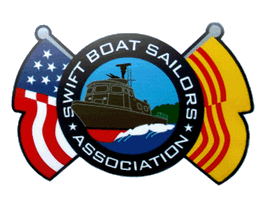
Article forward to VVA Chapter 1071 courtesy of Richard Cox - Chapter 1071 Vice President
Not long ago I was reminiscing with a friend about our common experiences in Vietnam. He mentioned that he had found some solace and emotional healing through reading a number of the stories in periodicals such as Vietnam Magazine. I asked him to lend me a copy and I was excited to find an interesting article about a member of a Swift Boat crew that I had been stationed with in Da Nang.
A knot rose in my throat as I read the part where Raul Herrera was asked "Did any Swift Boats capsize while you were there?" He recalled that at least one boat had capsized in the mouth of the Cua Viet river in November 1967
and that "miraculously the entire crew was saved." Amazing! It was MY BOAT CREW on PCF-58 that had saved those men on that unfortunate Swift!
A year before, in 1966, I was nearing my discharge date while serving aboard heavy cruiser Newport News. I
had been following the Vietnam war closely and had decided that I wanted to do my part in support of America's effort to relieve the suffering there. I wrote to the Navy and volunteered to extend my service for a year if they would allow me to serve with the Swift Boat squadron recently formed to patrol the coastal and river waters there.
Shortly thereafter I received orders to report to the PCF(Patrol Craft Fast) school in Coronado, California. While training with my crew, I was promoted to Boatswain Mate Second Class (E5) and became the leading petty officer for our crew when our senior engineman sustained an injury. We initially were sent to the Swift Boat coastal division in Qui Nhon, but were then transferred north to Da Nang where our boat subsequently was assigned duty at the U. S. Naval Support Activity Detachment located at the mouth of the Cua Viet river, just a few miles south of the Demilitarized Zone.
We were housed in barracks near the river mouth and daily went on patrols along the beaches and adjacent coastal area near the DMZ. Since there was little commercial traffic north of Da Nang, most of our days were spent searching sampans and junks for weapons and checking the identification of everyone we encountered on the waterways.
The most exciting part about operating from the Cua Viet was trying to safely return the boat and our crew to the
base via the treacherous channel at the entrance mouth of the river. The channel was about one-quarter
mile long and only about 200 feet wide. On a normal day the swells were usually five to ten feet high, and surfing down the channel in a fifty foot Swift Boat required considrable skill. The real problems occurred during the monsoon season when the waves in the channel were much larger. The challenge of surfing then
was comparable to long boarding in Hawaii ... but with five other lives depending on you. It was frightening!
On November 30, 1967, while patrolling just south of the DMZ, a suddenly approaching gale force storm surprised us and all three Swift Boats on patrol that day headed back to our Cua Viet base. The waves in the channel entrance were higher than I had ever seen before, and navigating the waves had to be the toughest challenge of my life to that point. Twice the waves we were surfing tried to turn our Swift sideways and swallow us whole. But by working the twin screws (you can't use the rudders when surfing) we managed to recover and keep the crest of the wave on our stern and the bow pointed straight.
We surfed past families in their sampans as they too retreated from the turbulent ocean. We all sighed with relief
as our ride on the wave ended in the safety of the calm Cua Viet river.
As we were securing the Swift to the small wooden dock, the other two boats that had arrived at the base before
us, sped past us and headed back up the channel. The crews waved for us to follow, yelling that sampans were sinking in the channel. I jumped behind the wheel as Bob Koger threw off the lines and we headed down the river at full throttle.
As we made it to the river mouth, a chill went through my body as I looked out into the channel, turbulent and
strewn with towering dark green white capped waves.
My eyes were riveted toward the strange shape of the Swift Boat that had just passed us. It was now upside
down in the middle of the channel. A wave had caught it broadside and flipped it over. Around the hull of the sinking Swift was its crew of six, plus dozens of drowning Vietnamese men, women and children. Some were clinging to their swamped sampans and others were disappearing with each violent wave that overtook them.
The remaining Swift in front of us, driven by a boatswain's mate named McDonald, headed toward the capsized
boat and started picking up the crew and the Vietnamese civilians. I went to the aft helm and guided the boat to individuals strewn among the waves and watched as my crew began pulling them from the water. After we had taken a few people aboard, I looked up and noticed that the waves were pushing McDonald's Swift dangerously close to the left side of the channel. He too was standing at the aft helm and the deck around him was full of the people his crew had rescued, including the crew of the Swift Boat that had just sunk. It was obvious that within a wave or two, McDonald's boat would surely get beached. It was time for him to make a decision. Suddenly I could see his left hand thrust both throttles forward and with his other hand he quickly spun the wheel to the right.
The events that took place over the next several seconds have replayed in my mind, in slow motion, for the past
35 years.
The waves pounding us were more than 15 feet high and the one that McDonald caught was at least 20 feet.
The twin V12s roared as he took the boat full speed into a hard right turn. The 50-foot long Swift Boat looked as small as a bobsled heading high into a banked turn on an Olympic bobsled run. The centrifugal force kept his boat high near the crest of the wave. His crew, plus the crew they rescued, and all of the Vietnamese fishermen and their families fell back into the water as the boat's angle went from 90 to 100 degrees inside the curl. We all thought that he was about to "wipe-out." Miraculously, McDonald was able to stand rigid, gripping the aft helm firmly as the Swift stayed in the curl and exited upright as he reached the right side of the channel.
The joy and thrill of seeing McDonald's boat escape disaster was immediately replaced by the sobering realization
that 11 sailors and dozens of Vietnamese now had to be rescued by our lone Swift. Since McDonald was the only
man left on his boat he had to abandon the rescue effort and head back to the river mouth. Most of those who were still floating were in a large group. I steered the Swift toward them while my crew went to the bow of the boat to start pulling the survivors aboard.
The huge relentless waves were getting larger and the interval between the waves became shorter. It was now
a struggle to keep my bow directed into the oncoming waves. This meant that it was nearly impossible to direct my boat to the people in the water. Just the slightest turn exposed us to the potential of capsizing and losing everyone we'd saved plus my crew and those still in the water. The waves were so steep and our bow so high at times, it felt as though we were standing upright on our stern. As the bow crashed back into the sea with every passing wave, those who were trying to swim close enough to reach an outstretched arm, were pushed away by the wake caused by our falling bow.
As I struggled to keep the Swift pointed into the oncoming waves while trying to navigate it toward those still in
the water, an Officer from one of the two crews floated next to my port position at the aft helm. He yelled to me to pull him from the water but with the waves coming as fast as they were, I couldn’t chance letting go of the wheel. I yelled and tried to get the attention of anyone on the bow of the boat, but the noise of the waves drowned me out. To my terror I discovered that while being distracted by the officer in the water, the bow of the Swift had drifted to port. The Officer was now a few feet past me and directly above my port screw. In that split second I realized that in order to prevent losing my boat in the next wave, I had to turn my stern toward the Officer, which meant the very real threat of his being sucked into my screws and chopped to pieces. I knew then that I had no choice but to risk his life. I yelled to the Officer to push away from the boat, warning him that I was bringing my
stern in his direction. His eyes went wide as he realized what I was telling him. He screamed at me and pleaded with me to pull him out, but I yelled at him one last time, "Push away now!" At that, I turned my head away from him not wanting to watch him being sucked into the screws. My boat was two seconds from being swamped by the next wave as I sent my port throttle full ahead and pulled my starboard throttle into full reverse.
It seemed like an eternity as my bow fought off the next wave and slowly straightened out. Anxiously I quickly
looked for the Officer but didn't see him. I stepped to the side and looked down. There he was, alive, flush alongside with his arms stretched out along the waterline as though he had suction cups in his palms. I left the wheel in God’s hands, took hold of a nearby stanchion in my left hand, and with my right, quickly reached down, grabbed his wrist, and with strength I have never felt before or since, I heaved him on deck in the blink of an eye. I took the time to whisper a short prayer of thanks as I jumped back to the helm.
As our deck slowly filled with dripping wet survivors, a crewman from the sunken Swift Boat slumped down next
to me at the helm and wept. He said, "I was trying to stay afloat with a little girl and boy under each arm but something hard struck me in the back of the head and we went under. I lost them both under the water." I was at a loss for words of comfort for him.
As the last person was pulled aboard I was faced with three major problems: First: The waves had moved us to
the left side of the channel, dangerously close to the shore; Second: I had to find a way to turn the boat around without losing everyone on board; Third: I now had my Boat Officer and the Officers from the other boats standing behind me. Each Officer had different directions as to how to turn the boat around. One suggested that I back the boat into the river mouth. But I dismissed that suggestion because, with the waves pushing us to the left, at some point I'd have to angle the Swift and expose her broadside to the waves in order to get into the river mouth. Another suggested that I take the same action as McDonald did but to start my move on the back of a wave. My Boat Officer suggested that I take her all the way out of the channel, into the ocean, turn her around, and then bring her back in. I pointed out the fact that, if the additional weight and the higher seas didn't
swamp us going out of the channel, they would definitely overtake us if we surfed back in. If we didn't do something quickly, the next two or three waves were destined to marry us to the shore. I yelled "Trust me!" and focused on the next wave.
As we climbed up the raging surf and our bow broke the wave's crest, I thrust the port throttle forward. We
started down the back of the wave just as I flung my wheel hard right, pulling back full throttle reverse on the starboard engine. Holding our breath, we braced ourselves as the boat pivoted just in time to catch the next wave flush on her stern. Thrusting forward with both engines at maximum throttle, we instantly matched the wave's speed and all hands cheered as the wave picked us up and delivered us safely to the
calm of the river's mouth.
Unfortunately, many civilians died that day. But many more would have, had it not been for the actions of the
heroic Swift crews. Although no one received medals or commendations, the sailor's reward was knowing that every future generation born to those who were saved that day will be to the credit to the crews of the three Swift Boats that did not hesitate to attempt the rescue in extremely dangerous circumstances.
A knot rose in my throat as I read the part where Raul Herrera was asked "Did any Swift Boats capsize while you were there?" He recalled that at least one boat had capsized in the mouth of the Cua Viet river in November 1967
and that "miraculously the entire crew was saved." Amazing! It was MY BOAT CREW on PCF-58 that had saved those men on that unfortunate Swift!
A year before, in 1966, I was nearing my discharge date while serving aboard heavy cruiser Newport News. I
had been following the Vietnam war closely and had decided that I wanted to do my part in support of America's effort to relieve the suffering there. I wrote to the Navy and volunteered to extend my service for a year if they would allow me to serve with the Swift Boat squadron recently formed to patrol the coastal and river waters there.
Shortly thereafter I received orders to report to the PCF(Patrol Craft Fast) school in Coronado, California. While training with my crew, I was promoted to Boatswain Mate Second Class (E5) and became the leading petty officer for our crew when our senior engineman sustained an injury. We initially were sent to the Swift Boat coastal division in Qui Nhon, but were then transferred north to Da Nang where our boat subsequently was assigned duty at the U. S. Naval Support Activity Detachment located at the mouth of the Cua Viet river, just a few miles south of the Demilitarized Zone.
We were housed in barracks near the river mouth and daily went on patrols along the beaches and adjacent coastal area near the DMZ. Since there was little commercial traffic north of Da Nang, most of our days were spent searching sampans and junks for weapons and checking the identification of everyone we encountered on the waterways.
The most exciting part about operating from the Cua Viet was trying to safely return the boat and our crew to the
base via the treacherous channel at the entrance mouth of the river. The channel was about one-quarter
mile long and only about 200 feet wide. On a normal day the swells were usually five to ten feet high, and surfing down the channel in a fifty foot Swift Boat required considrable skill. The real problems occurred during the monsoon season when the waves in the channel were much larger. The challenge of surfing then
was comparable to long boarding in Hawaii ... but with five other lives depending on you. It was frightening!
On November 30, 1967, while patrolling just south of the DMZ, a suddenly approaching gale force storm surprised us and all three Swift Boats on patrol that day headed back to our Cua Viet base. The waves in the channel entrance were higher than I had ever seen before, and navigating the waves had to be the toughest challenge of my life to that point. Twice the waves we were surfing tried to turn our Swift sideways and swallow us whole. But by working the twin screws (you can't use the rudders when surfing) we managed to recover and keep the crest of the wave on our stern and the bow pointed straight.
We surfed past families in their sampans as they too retreated from the turbulent ocean. We all sighed with relief
as our ride on the wave ended in the safety of the calm Cua Viet river.
As we were securing the Swift to the small wooden dock, the other two boats that had arrived at the base before
us, sped past us and headed back up the channel. The crews waved for us to follow, yelling that sampans were sinking in the channel. I jumped behind the wheel as Bob Koger threw off the lines and we headed down the river at full throttle.
As we made it to the river mouth, a chill went through my body as I looked out into the channel, turbulent and
strewn with towering dark green white capped waves.
My eyes were riveted toward the strange shape of the Swift Boat that had just passed us. It was now upside
down in the middle of the channel. A wave had caught it broadside and flipped it over. Around the hull of the sinking Swift was its crew of six, plus dozens of drowning Vietnamese men, women and children. Some were clinging to their swamped sampans and others were disappearing with each violent wave that overtook them.
The remaining Swift in front of us, driven by a boatswain's mate named McDonald, headed toward the capsized
boat and started picking up the crew and the Vietnamese civilians. I went to the aft helm and guided the boat to individuals strewn among the waves and watched as my crew began pulling them from the water. After we had taken a few people aboard, I looked up and noticed that the waves were pushing McDonald's Swift dangerously close to the left side of the channel. He too was standing at the aft helm and the deck around him was full of the people his crew had rescued, including the crew of the Swift Boat that had just sunk. It was obvious that within a wave or two, McDonald's boat would surely get beached. It was time for him to make a decision. Suddenly I could see his left hand thrust both throttles forward and with his other hand he quickly spun the wheel to the right.
The events that took place over the next several seconds have replayed in my mind, in slow motion, for the past
35 years.
The waves pounding us were more than 15 feet high and the one that McDonald caught was at least 20 feet.
The twin V12s roared as he took the boat full speed into a hard right turn. The 50-foot long Swift Boat looked as small as a bobsled heading high into a banked turn on an Olympic bobsled run. The centrifugal force kept his boat high near the crest of the wave. His crew, plus the crew they rescued, and all of the Vietnamese fishermen and their families fell back into the water as the boat's angle went from 90 to 100 degrees inside the curl. We all thought that he was about to "wipe-out." Miraculously, McDonald was able to stand rigid, gripping the aft helm firmly as the Swift stayed in the curl and exited upright as he reached the right side of the channel.
The joy and thrill of seeing McDonald's boat escape disaster was immediately replaced by the sobering realization
that 11 sailors and dozens of Vietnamese now had to be rescued by our lone Swift. Since McDonald was the only
man left on his boat he had to abandon the rescue effort and head back to the river mouth. Most of those who were still floating were in a large group. I steered the Swift toward them while my crew went to the bow of the boat to start pulling the survivors aboard.
The huge relentless waves were getting larger and the interval between the waves became shorter. It was now
a struggle to keep my bow directed into the oncoming waves. This meant that it was nearly impossible to direct my boat to the people in the water. Just the slightest turn exposed us to the potential of capsizing and losing everyone we'd saved plus my crew and those still in the water. The waves were so steep and our bow so high at times, it felt as though we were standing upright on our stern. As the bow crashed back into the sea with every passing wave, those who were trying to swim close enough to reach an outstretched arm, were pushed away by the wake caused by our falling bow.
As I struggled to keep the Swift pointed into the oncoming waves while trying to navigate it toward those still in
the water, an Officer from one of the two crews floated next to my port position at the aft helm. He yelled to me to pull him from the water but with the waves coming as fast as they were, I couldn’t chance letting go of the wheel. I yelled and tried to get the attention of anyone on the bow of the boat, but the noise of the waves drowned me out. To my terror I discovered that while being distracted by the officer in the water, the bow of the Swift had drifted to port. The Officer was now a few feet past me and directly above my port screw. In that split second I realized that in order to prevent losing my boat in the next wave, I had to turn my stern toward the Officer, which meant the very real threat of his being sucked into my screws and chopped to pieces. I knew then that I had no choice but to risk his life. I yelled to the Officer to push away from the boat, warning him that I was bringing my
stern in his direction. His eyes went wide as he realized what I was telling him. He screamed at me and pleaded with me to pull him out, but I yelled at him one last time, "Push away now!" At that, I turned my head away from him not wanting to watch him being sucked into the screws. My boat was two seconds from being swamped by the next wave as I sent my port throttle full ahead and pulled my starboard throttle into full reverse.
It seemed like an eternity as my bow fought off the next wave and slowly straightened out. Anxiously I quickly
looked for the Officer but didn't see him. I stepped to the side and looked down. There he was, alive, flush alongside with his arms stretched out along the waterline as though he had suction cups in his palms. I left the wheel in God’s hands, took hold of a nearby stanchion in my left hand, and with my right, quickly reached down, grabbed his wrist, and with strength I have never felt before or since, I heaved him on deck in the blink of an eye. I took the time to whisper a short prayer of thanks as I jumped back to the helm.
As our deck slowly filled with dripping wet survivors, a crewman from the sunken Swift Boat slumped down next
to me at the helm and wept. He said, "I was trying to stay afloat with a little girl and boy under each arm but something hard struck me in the back of the head and we went under. I lost them both under the water." I was at a loss for words of comfort for him.
As the last person was pulled aboard I was faced with three major problems: First: The waves had moved us to
the left side of the channel, dangerously close to the shore; Second: I had to find a way to turn the boat around without losing everyone on board; Third: I now had my Boat Officer and the Officers from the other boats standing behind me. Each Officer had different directions as to how to turn the boat around. One suggested that I back the boat into the river mouth. But I dismissed that suggestion because, with the waves pushing us to the left, at some point I'd have to angle the Swift and expose her broadside to the waves in order to get into the river mouth. Another suggested that I take the same action as McDonald did but to start my move on the back of a wave. My Boat Officer suggested that I take her all the way out of the channel, into the ocean, turn her around, and then bring her back in. I pointed out the fact that, if the additional weight and the higher seas didn't
swamp us going out of the channel, they would definitely overtake us if we surfed back in. If we didn't do something quickly, the next two or three waves were destined to marry us to the shore. I yelled "Trust me!" and focused on the next wave.
As we climbed up the raging surf and our bow broke the wave's crest, I thrust the port throttle forward. We
started down the back of the wave just as I flung my wheel hard right, pulling back full throttle reverse on the starboard engine. Holding our breath, we braced ourselves as the boat pivoted just in time to catch the next wave flush on her stern. Thrusting forward with both engines at maximum throttle, we instantly matched the wave's speed and all hands cheered as the wave picked us up and delivered us safely to the
calm of the river's mouth.
Unfortunately, many civilians died that day. But many more would have, had it not been for the actions of the
heroic Swift crews. Although no one received medals or commendations, the sailor's reward was knowing that every future generation born to those who were saved that day will be to the credit to the crews of the three Swift Boats that did not hesitate to attempt the rescue in extremely dangerous circumstances.
_________________________________________________________________________
Dan Dietz
_________________________________________________________________________
ROBERT DORISS - On the anniversary of a death by war.
_________________________________________________________________________
C V Egan
_________________________________________________________________________
Tony Lopez
41 years later........ "Hi Ted, remember me?"
While perusing the guest book of the Southeast Asia, Army Security Agency Association website in December 2012, I came across a very familiar name. Ted Garcia and I had spent the majority of our service time together.....Advanced Individual Training at Ft. Devens, MA, then on to Vietnam and then to our final mission at Vint Hill Farms Station in Northern Virginia. Recently, we have had some great "conversations" via email and Facebook. Below are a few of the pictures we have shared from "back in the day."
1970 to 1971 Ft Devens, MA and Pleiku and Nha Trang, Vietnam
Ted and I returned from Vietnam together on the same Freedom Flight
TODAY
Glad I found you, Ole Buddy!
DO YOU REMEMBER?!
Did you ever experience the awe of "Puff" doing his work at night. These photos were taken by Clyde "Rowdy" Yates in the Nha Trang, Vietnam area in 1968-69. Mr. Yates was with the 313th Radio Research Battalion (Army Security Agency).
Puff was still doing his job later on at the same place in 1970-71.
_________________________________________________________________________
David Steiner
DENVER CHAPTER OF VVA
Below is an article written by our Chapter member, David Steiner. The article discusses the potential formation of a new Vietnam Veterans of America Chapter in the Denver area.
This article was first published in the Denver Post and appears here with the permission of David Steiner.
This article was first published in the Denver Post and appears here with the permission of David Steiner.
Your browser does not support viewing this document. Click here to download the document.

